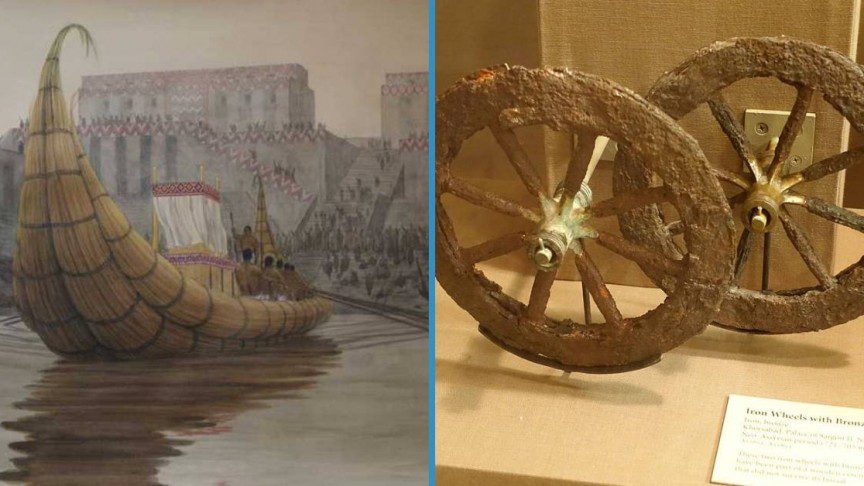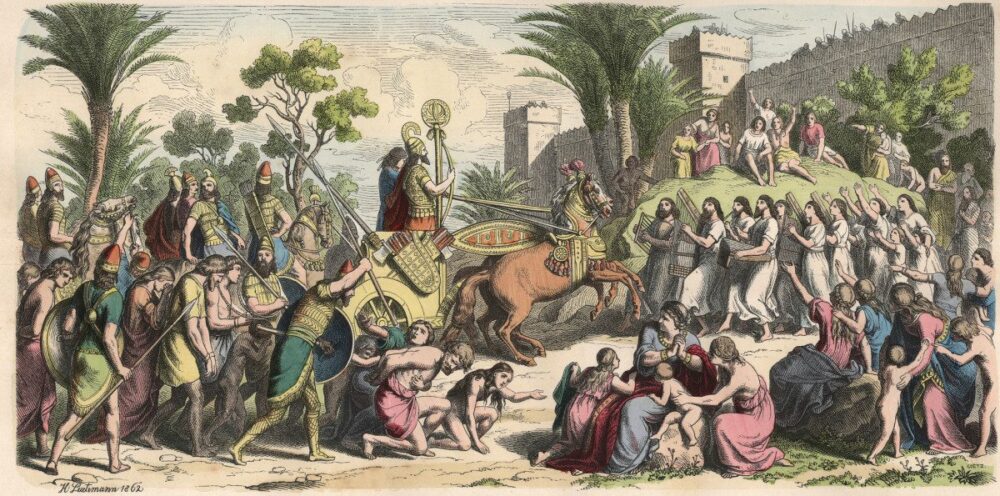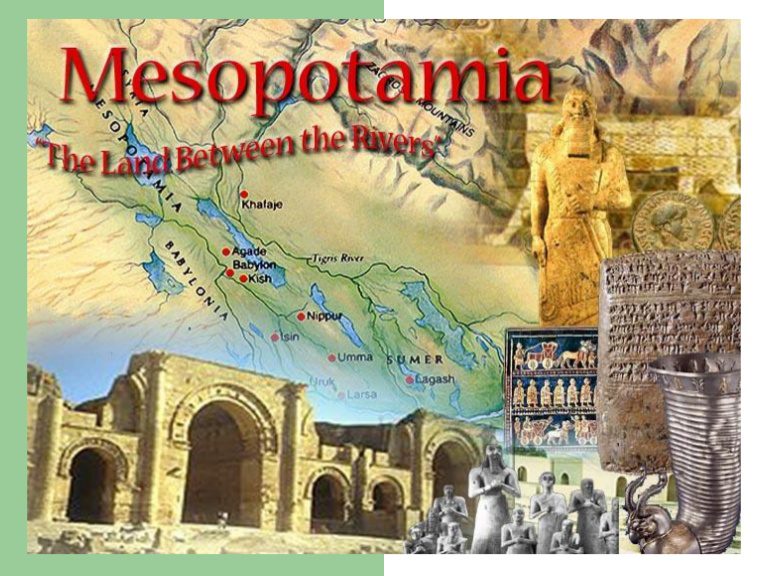
The saga of civilizations itself starts up in one location, not Egypt not Greece, not Rome but “MESOPOTAMIA” situated between the river Tigris and the river Euphrates. For five millennia this exceedingly fertile insignificant piece of land which is situated in what is present-day Iraq, Kuwait, Syria boosted innovation that shaped the world. Its stable climate-rich soil and a steady supply of water made it ideal for agriculture to develop and thrive which gave rise to some of the world’s cities – UR, URUK, BABYLON, AKKAD, and ASHUR.
Mesopotamia was spotted with a constellation of city-states. Despite constant battles, innovation and advancement prospered in age-old Mesopotamia from palaces to ziggurats, developed Advanced mathematics including a base 60 system, mapped sky but most substantial innovation to come out is literacy what began as simple pictures doodled onto wet clay developed into a sophisticated writing system.
Mesopotamia was consolidated under the Akkadian Empire which then broke apart into Assyria and Babylon. The latter was authorized by King Hammurabi, who substantiated too rich a state to withstand outside envy which finally led to multiple foreign incursions on the soil of Mesopotamia. Eventually, Mesopotamia would disappear like its monarch into the mist of history and its cities would collapse beneath the sands of Iran but its idea would prosper in literacy, law, math, astronomy, and the gift of civilization itself.
This land is remembered as the “Cradle of Civilization” for the abundance of innovations that arose from the early societies in this region, which are among some of the earliest known human civilizations on earth.
Early Fabrications that Help Transform the World

- Wheels- First emerged in ancient Mesopotamia more than 5,000 years ago, they were initially used by potters to aid shape clay later on they were equipped with carts which made shifting an object easy. Therefore the first wheel wasn’t used for transportation.
- Sailboats- Sumerians realized that transportation through the ocean would be a lot manageable which guided the construction of the first sailboat that had a basic simple design.
- Concept of Time- Mesopotamians formulated this by dividing time units into 60parts. That directed to 60-second minutes, 60-minutes hours, and a 360-degree circle. Astronomical estimations were taken by Babylonians.
- Astronomy and Astrology- The notion was cultivated by the Sumerian period. It was assumed by them that every good or bad thing occurred for a reason. They mapped the activity of the sky the sun and the stars to anticipate or foresee cosmic events. They fabricated a 7-day week and 12-month year theory by examining the settings of the planet. Which later on was embraced by Greeks into what we see as our sunshine today.
- Mathematics- When civilization blossomed people started to trade/deal and they needed a valid system for the goods/trade. Sumerians were the first on earth to formulate the idea of counting. They developed a sexagesimal system (base 60 division). It enabled them to develop the system of the 12-month year. Babylonians even nurtured the concept of what is known as the Pythagoras Theorem.
- The First Form of Writing- Sumerians developed writing called “cuneiform” to maintain the business record. It was mostly used in a trade where merchants recorded information such as the number of grains, to which place, and the number of animals. This script is not a language but 600-1200 pictures.
Trade Relations
Mesopotamia formulated a diversity of goods from fine textiles to sturdy, nearly mass-produced pottery made in temple workshops to leather goods, jewelry, basketry, devotional figurines, and ivory carvings among others. Agricultural products such as grains and cooking oils were also shipped as were dates and flax. Overland trade routes were traced to the east over the Zagros Mountains into present-day Iran and Afghanistan. An active sea route took off through the Persian Gulf across the Arabian Sea to the Indus valley in what is today’s northern India and Pakistan.
By the time of the Assyrian Empire, Mesopotamia was exchanging exporting grains, cooking oil, pottery, leather goods, baskets, textiles, and jewelry and importing Egyptian gold, Indian ivory and pearls, Anatolian silver, Arabian copper, and Persian Tin.
Trade was invariably crucial to resource Mesopotamia. The exchange was also a blessing for human interchange, giving rise to cross-cultural connection to entirely a unique level. The first long-distance trade happened between Mesopotamia and the Indus Valley in Pakistan. Which was specified almost exclusively to luxury goods like spices, textiles, and precious metals.
The archaeological proof indicates trade alliance during the later 3rd millennium was a direct one ships from Meluhha (the Indus) anchored in Mesopotamian ports; some Meluhhans settled in Mesopotamia, and there is a seal which concludes that there is a Mesopotamian whose task was to conduct interpretation of the Meluhhan dialects. The Harappans performed trade between the two civilizations. Mesopotamian ships sailed the length of the Gulf, as far as the western coast of Magan (Oman peninsula), trading directly with Magan and with Dilmun.
Life in Mesopotamia

Complex Religion- Mesopotamia practiced a polytheistic belief system and hence worshipped many gods and goddesses. They were worshippers of nature. They were of the belief that these supernatural deities help them face danger and their fears. Each Mesopotamian city had its patron god and maximum of what we comprehend of them has been passed down through clay tablets portraying its sacred assumptions and habits.
MARDUK – Supreme God
ISHTAR – Mother of all Gods
SHAMASH – Sun God
NANMAR – Moon God
BEL – Goddess of Death
ASSUR – God of War
EA – God of wisdom and magic
Political Life- King was the head of administration, he was seen as representative of God on earth and owner of the property of the state. Six social classes were present including King, Priest, Scribes, Merchants, Artisans, Commoners, Slaves. At the top rank of social order has to be The king who served as head of the army. Followed by a priest who was part of the upper class and was considered a doctor of that particular period.
The priest was more influential than King due to the link he provided between people and gods. Scribes were upper class and well educated. Then came artisans who had a major role in creating wealth and the growth of civilization. At the bottom, we see commoners and slaves.
Economic Conduct- Wheat barley fruits and dates were ripened in excess and sent abroad. Prematurely utilized barter system later they expended metal coins. Weaving pottery jewelry mining and metallurgy were important crafts. They shipped wooden fiber clothing and had business connections with India and Egypt.
Art and Craft- the significance of this duration also conforms to the firstest use of painted jewel on pottery vessels. The structures on their pottery sometimes were seen in more than one color, usually consist of zones served with “geometric” decoration in diagrams reminiscent of woven textures. Pottery that emerges consists of impressions of the animal, bird, or even human figures, ingeniously stylized and aesthetically impressive.
The other outstanding composition or art form prominently at this time is that of hominoid statuettes of stone or clay, related to basic religious cults. Cuneiform and pictograms imply the excess of pottery and other artistic traditions. In addition to the creation of vessels, clay was also utilized to bring in tablets for inscribing inscribed statements. Metal also fulfilled numerous objectives during the early Sumerian period. Smiths used a form of casting to create the blades for daggers. On the other hand, softer metals like copper and gold could be hammered into the forms of plates, necklaces, and collars.
The Decline of Mesopotamia civilization
New studies suggest that fateful dust storms put an end to the entire Mesopotamia. The kingdoms were incapable to withstand the devastating after-effects of dust storms ensuing in fluctuation to grown harvests, starvations, and mass social upheaval. Other researches reflect the modification in climatic circumstances or variations in a climate that contributed to the decline.
Very unpopular assumptions are of numerous incursions on Mesopotamia by other society or civilization, the invasion of Persian led to the end of this civilization or vulnerable and inadequate leaders lost discretion over an administration which led to anarchy. Clash for progression among the Nobels unsettled peace and order in society.
Plan Your Next Trip To Chittorgarh Fort – The Pride Of Rajasthan

